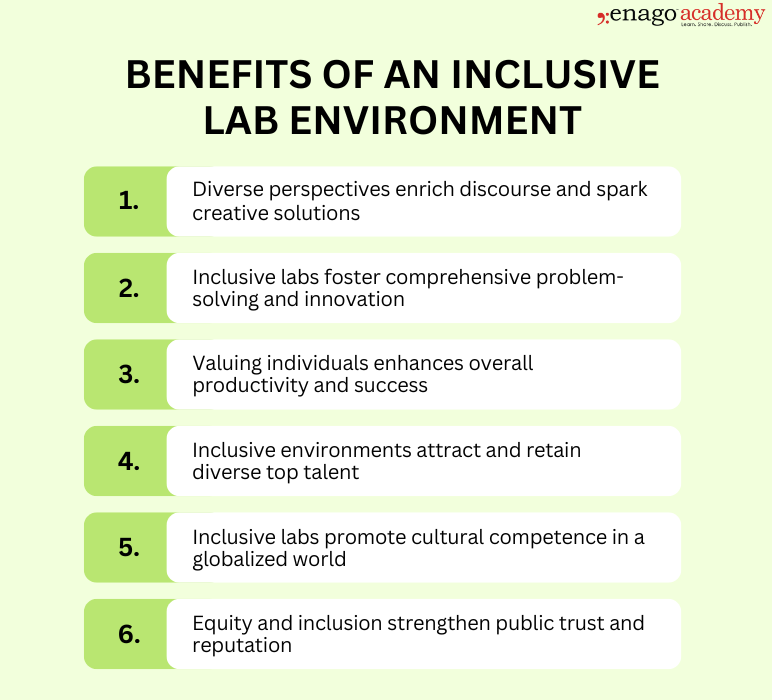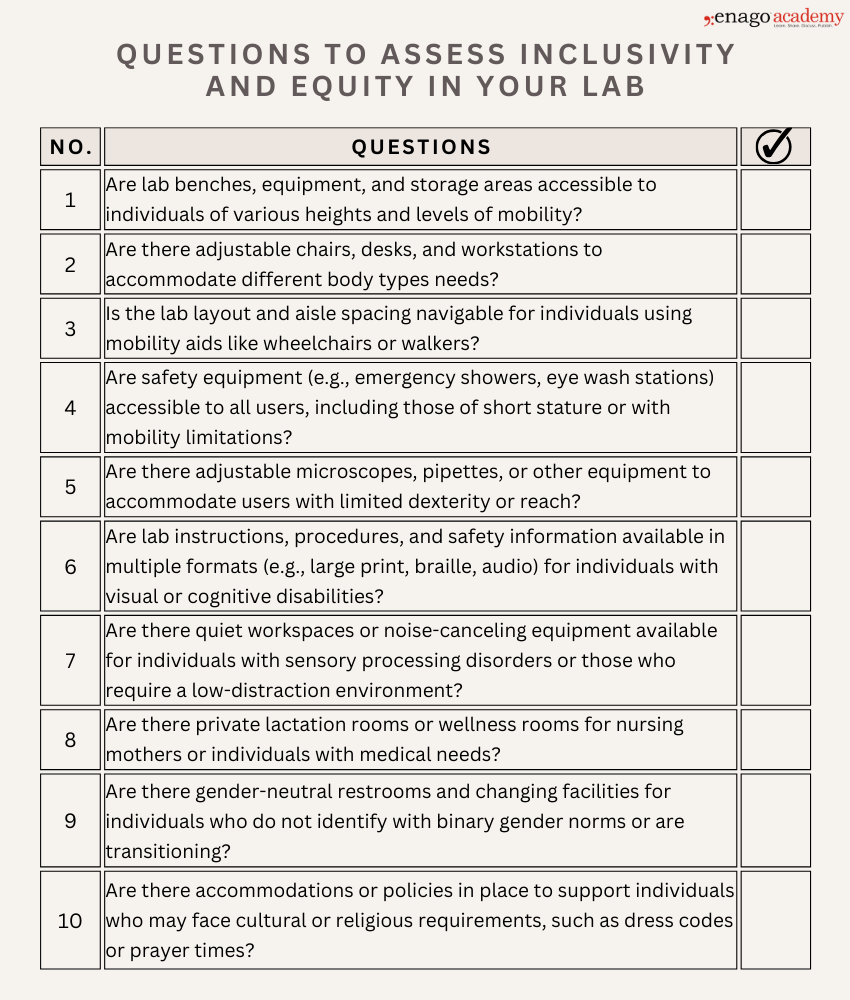Reassessing the Lab Environment to Create an Equitable and Inclusive Space

The pursuit of scientific discovery has long been fueled by diverse minds and perspectives. Yet within the laboratories, a troubling trend persists. Only a mere 33% of researchers globally are women, and marginalized communities remain vastly underrepresented. This disparity undermines not only the principles of equity and justice but also our collective ability to unlock human potential to its fullest.
Research shows that underrepresented students are more likely to pursue advanced degrees and careers in academia or research fields when they get the opportunity to actively engage in research and positively interact with faculty mentors. However, barriers to entry and inclusion within lab environments continue to obstruct this empowering path.
This irony is stark — the spaces meant to expand knowledge are constrained by silencing voices that could catalyze revolutionary breakthroughs. In this climate of inequity, an urgent call to reassess our lab environment rings clear.
Benefits of an Inclusive Lab Environment
Cultivating an inclusive lab environment results in an equitable environment fosters a sense of belonging, boosting overall productivity, success, and retention of talented individuals from all backgrounds.
The benefits of an inclusive lab environment include:
1. Diverse Perspectives and Ideas
When individuals from diverse backgrounds collaborate, they bring unique lived experiences, cultural perspectives, and cognitive frameworks to the table, catalyzing intellectual synergy and sparking creative solutions.
2. Improved Problem-solving and Innovation
By leveraging the collective wisdom of diverse minds, teams are better equipped to identify blind spots, challenge assumptions, and devise ground-breaking solutions that might otherwise remain elusive.
3. Enhanced Overall Productivity and Success
When researchers feel valued and supported, they are more likely to thrive, fostering heightened productivity, job satisfaction, and long-term success for the entire team.
4. Increased Talent Attraction and Retention
An inclusive lab environment that celebrates diversity and provides equal opportunities for advancement can serve as a powerful recruitment and retention tool. By fostering a welcoming culture, labs can tap into a broader pool of exceptional individuals from various backgrounds, ensuring a rich diversity of expertise and perspectives.
5. Improved Cultural Competence
Cross-cultural exchange and collaboration not only promotes personal growth but also equips researchers with the skills necessary to collaborate effectively with global teams, navigate cultural nuances, and effectively communicate scientific findings to diverse audiences.
6. Enhanced Public Trust and Reputation
By demonstrating a genuine commitment to equity and inclusion, labs can strengthen their reputation and build trust globally. This can facilitate valuable collaborations, attract funding and support, and ultimately contribute to the advancement of scientific knowledge for the betterment of society as a whole.
 Assessing Inclusivity and Equity in Lab Spaces
Assessing Inclusivity and Equity in Lab Spaces
The first step to creating inclusive and equitable lab environment is critical examination of existing practices and structures.
Key questions that can help you gauge the inclusivity and equity of your lab include:
 7 Ways Lab Managers Can Cultivate a Diverse and Inclusive Environment
7 Ways Lab Managers Can Cultivate a Diverse and Inclusive Environment
Fostering an inclusive culture in laboratories requires a deliberate effort from leadership, particularly Lab Managers and Principal Investigators (PIs). Before delving into their essential roles, it’s crucial to understand the distinction between equality and equity.
Imagine people trying to watch a baseball game over a tall fence. Equality would give everyone the same size crate to stand on, but some would still struggle to see over the fence due to their varying heights. Equity, on the other hand, would provide each person with the appropriate number of crates needed, ensuring everyone can comfortably view the game regardless of their individual circumstances.
Here are some key responsibilities and actions they can take:
Lab managers and PIs play a pivotal role in championing equity and creating an inclusive environment within their laboratories. Their leadership and advocacy are essential in driving cultural change and setting the tone for an inclusive and welcoming space.
7 Strategies to Promote an Inclusive and Equitable Lab Environment
Creating a truly inclusive and equitable lab culture requires a multifaceted approach that addresses various aspects of the work environment and experience. By implementing the key strategies, lab leaders can cultivate a space where diversity is celebrated, and all individuals feel valued, supported, and empowered to reach their full potential.
1. Recruiting and Retaining a Diverse Workforce
Actively seek out and hire individuals from underrepresented groups, including women, racial and ethnic minorities, individuals with disabilities, and individuals from diverse socioeconomic backgrounds. Implement targeted recruitment efforts by attending career fairs at minority-serving institutions, partnering with diversity organizations, and ensuring job postings are widely distributed. Once hired, provide support and resources to help retain diverse talent.
2. Providing Accommodations and Flexibility
Ensure that the lab is accessible and compliant with the Americans with Disabilities Act (ADA) or relevant laws. Provide reasonable accommodations, such as assistive technologies, modified workstations, and flexible work arrangements. Offer flexible work arrangements, such as telecommuting options, flexible schedules, and generous family leave policies. Provide resources and support for caregivers, such as on-site childcare facilities or referral services.
3. Creating Accessible and Inclusive Physical Spaces
Design lab spaces that are accessible to individuals with disabilities, including wheelchair-accessible entrances, restrooms, and workstations. Ensure that signage is clear and visible, and that lab equipment and tools are ergonomically designed for diverse users.
4. Celebrating Diversity and Cultural Events
Recognize and celebrate cultural holidays and events that are significant to the diverse members of your lab. Encourage employees to share their cultural traditions and experiences through presentations, potlucks, or other events. Foster an environment where individuals feel comfortable expressing their cultural identities and learning from one another.
5. Continuous Diversity and Inclusion Training
Implement regular training sessions on topics such as unconscious bias, cultural competency, and inclusive leadership. These trainings should be mandatory for all lab members, including leadership and management. Encourage open dialogues and provide opportunities for individuals to share their perspectives and experiences.
6. Providing Mentorship Opportunities
Establish formal mentorship programs that pair individuals from underrepresented groups with experienced mentors who can provide guidance, support, and advocacy. Mentors can help navigate the lab environment, offer career advice, and serve as role models for their mentees.
7. Engaging in Ally Behaviors
Encourage all lab members to actively promote inclusivity and advocate for underrepresented groups. Allies can amplify voices, challenge discriminatory behaviors, and create a supportive environment for their colleagues from diverse backgrounds.
By implementing these strategies, labs can create a more inclusive and equitable environment that values diversity, promotes mutual respect, and fosters a sense of belonging for all individuals.
While individual labs can take significant strides toward inclusivity, lasting transformation requires a collective commitment to systemic change. Researchers, institutions, and organizations must unite in their efforts to challenge longstanding biases and dismantling barriers that hinder equitable participation in scientific endeavors.
Have you encountered disparities in your lab environment? Share your story to drive change by contributing to our Open Platform.
















